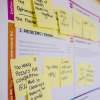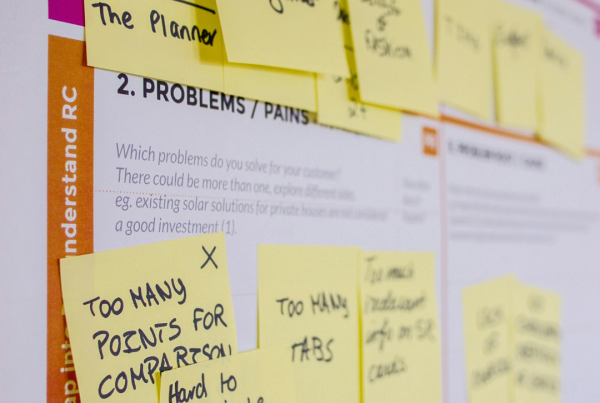As the founder and principal of a UX design agency, I’m always thinking of my clients. Anyone who has ever worked in an agency will tell you that we try very hard to meet or exceed clients’ expectations. I mean, it’s our bread and butter. When my team is designing digital products for our clients, we’re thinking about their users and their expectations. And when I’m facilitating design sprints, I’m always paying attention to the group, whether they’re following me, have lost it, or just over the sprint session.
It’s fair to say customer service is two-fold for us at Relab Studios – for our clients and their users whom we design products for. Being customer-centric requires a lot of empathy, to put yourself in another’s shoe. Empathy is the bedrock of UX, and it can be transformational for your company culture. If every one of your employees were a little more empathic towards the customer and each other, you’ll not only create true brand loyalty, but also an environment where people genuinely feel fortunate to work in.
Everyone can be a customer advocate in your company. You don’t have to be working in customer service, UX, or be responsible for customer retention rates. This is what a customer-centric culture is – all hands are on board for the customers. A Microsoft report on the state of customer service in 2017 found that 96% of people surveyed said customer service plays a role when choosing a brand. Based on data from Bain & Co, companies with exceptional customer experience grew their income at 4%-8% above the market average.
Although I’m still learning to improve myself and Relab, I’d like to share some lessons I learnt along the way on how to make the company culture more empathic to customers.
1. It’s a long-term commitment
In a world of instant gratification, it’s easy to throw in the towel when there’s not much result to show for. That’s how it will be. Transforming a company culture isn’t instant, and at times you’ll wonder if it will bear fruit. Remember, you’re trying to change mindsets. If you’re thinking months, then extend it to years. Bottom line is, you’re in for the long haul.
2. It starts with you
It’s cliché but it’s true. You need to be more emphatic and understanding if you want this to work. Start paying attention to people’s tone of voice, reaction, and expression. Most of communication is non-verbal. According to Albert Mehrabian, a body language expert, communication is 55% nonverbal, 38% vocal, and only 7% words. Some people are naturally good at reading reactions and body language, and then empathising with that. This is a valuable skill you can learn slowly.
3. Implement direct interaction with customers
If you haven’t done so already, this will be eye opening to the decision makers in the business. Getting them to interact directly with the customers, whether face-to-face or virtual, is part of being a customer-centric company and fosters a positive customer experience. We do this somewhat in design sprints, on the last day, when we test our prototypes. Although we have experts to conduct the user testing, it’s good to have decision makers sit in and observe the sessions to truly understand the impact of their products.
4. Integrate your teams
This is something I see quite often in businesses with teams working in silos. When an issue pops up, the buck gets passed around from team to team, leader to leader, like a pinball, and nothing gets resolved in the end.
In design sprints, we get teams from different departments to come together and solve one problem, which is a more effective way to tackle a problem. And it also promotes empathy among your teams because they will get to understand the other person’s point of view, and identify gaps in the company’s processes.
5. Give everyone access to customer insight
This is another simple way to empower your employees. Customer feedback and insight shouldn’t just be in the hands of few. You don’t have to provide detailed data, but enough for your employees to know the customer profile, their pain points and how we help them. Having access to this information is the fastest way to get people to think differently, and be better in their job.
6. Design the right process
You can conduct as many surveys and interviews as you want to gather feedback, but it won’t amount to anything if the feedback doesn’t get to the right people, or gets actioned. Think about your workflow, the teams involved and understand what happens when an issue arise, or when you get substantial customer feedback.
Then, redesign the process to achieve the goal of making the voices of your customers heard, and their problems attended to. You won’t get to please every single customer, but you can make sure the majority of them feel like you care about their issues.
7. Get buy-in
For a successful cultural change, you must get buy-ins from your people. There are many ways to do it, but the key is to be consistent with your communication, and keep an open line of communication with your employees. It’s crucial to ensure everybody understands the concept and the importance of customer centricity. And you must also allow employees to ask questions, raise their concerns and provide constructive feedback to your plans.
8. Incentivise
Incentives work when you’re trying to instil positive habits in your employees. It doesn’t always have to be monetary, even an award and celebration for a job well done for your customers will suffice. The important thing is to build a culture of rewarding people who choose to advocate for the customers, even when it’s not in their job scope.
9. Hire well, then train them even better
Everyone knows that too many bad hires will ruin your culture quicker than any strategic plan and initiatives. Bake customer centricity into your job descriptions and interview process. And once you’ve hired them, train them well and arm them with the right tools to become supporters of your customers.







